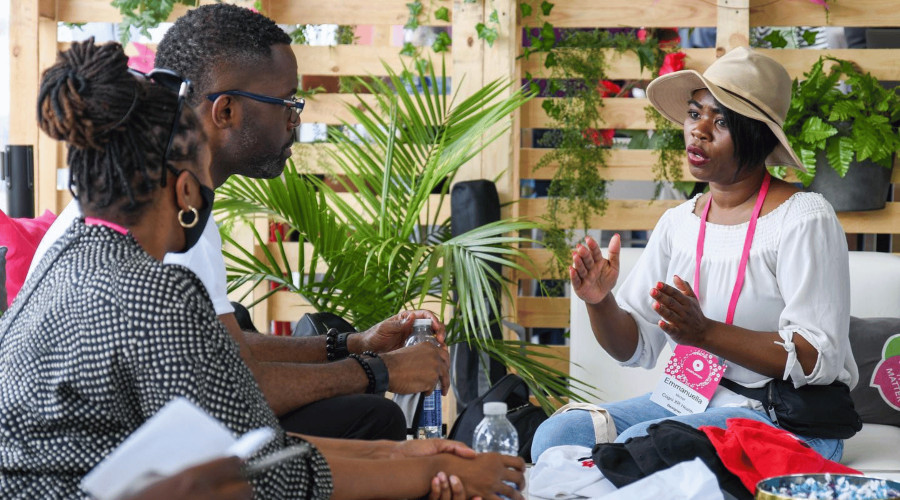Given these struggles, is now the right time for Black entrepreneurs to take on new loans to further their businesses?
The Federation for African Canadian Economics (FACE), a non-profit group of Black innovators and administrators, seems to think so.
Inaugurated in 2021, FACE’s stated mission is “to drive generational wealth powered by sustainable economic resources, capacity and strategic partnerships.”
In 2021 the group partnered with the Business Development Bank of Canada (BDC) and two credit unions (Vancity and Alterna Savings) to offer the first Black-focused entrepreneurship loan program in Canada, the Black Entrepreneurship Loan Fund (BELF). The BELF allocates $160 million to Black Canadian businesses through a macro and micro-loans program.
In partnership with Vancity and Alterna Savings credit unions, the micro-loans provide amounts ranging from $10,000 to $25,000. In contrast, macro loans distributed by the Government of Canada and the Development Bank of Canada (BDC) range from $25,000 to $250,000.
Tiffany Callender, CEO of FACE, believes the program can be a springboard to economic achievement even in tough economic times.
“By creating the loan program, we are allowing Black entrepreneurs to start or scale businesses as a pathway to creating wealth.”
A loan program in Canada has never been created explicitly for Black entrepreneurs. While some individuals can increase their wealth through debt-fuelled entrepreneurship, many more will be put into poverty, which may deprive BELF of any sustainable financing going forward.
The Bank That is Not a Bank
Since its first cohort, the loan program has distributed $25.4 million, and successfully increased its distributed loan amount by 112% after its first year of operation.
The program works with participants directly to provide loans, but Callender was clear:
“We’re not a bank. We can't deposit money in your bank account. Furthermore, we require a partner.”
While a bank like TD has permission to hold onto your money, FACE must go through the BDC. The Business Development Bank of Canada (BDC) is a Crown corporation and national development bank wholly owned by the Government of Canada. It is mandated to help create and develop Canadian small and medium-sized businesses. While FACE is not a bank, its interaction with the BDC has given it the same institutional flaws Black entrepreneurs face in the private market.
We asked FACE to connect us with some business owners who had received loans through the BELF program. We were introduced to two business owners, married couple Kevin and Willie Bailey of Ladies Love Units and Myriam Jean-Baptiste, founder of LS Cream Liqueur. Jean-Baptiste backed out of the interview process due to last-minute travel plans, while Kevin and Willie seemed hesitant to give detailed answers about their experience with the BELF fund.
Via email, the founders of the Toronto custom wig-making company shared that they decided to apply for a loan with FACE after dealing with constant issues within the private market. They recall facing significant barriers to accessing finance despite having a track record of success. The most significant barriers they mentioned were the high collateral needs and the onerous application process. This is on brand with several studies that show systemic discrimination at Canada’s largest banks.
When the Baileys came to FACE, they expected better but said they got similar treatment.
“We encountered challenges that made it feel daunting and reminiscent of applying to traditional banks. The requirements became more stringent, the documentation more complex, and the timeline for approval seemed prolonged,” they wrote in an email to ByBlacks.com.
The levels of bureaucracy and documentation are typical due diligence approaches that FACE has adopted. They are essential for developing fair interest rates, often cheaper than private rates. For example, you can get a 5% interest rate from FACE, compared to a 7% interest rate from a traditional bank. But a cheaper rate doesn’t mean the program is sustainable.
How to Build Financial Sustainability
While cheaper than private banks, the BELF still requires a profit from their loans. The profits from interest rates are meant to be put back into the fund for next year's cohort of entrepreneurs. But if statistically most businesses fail, how can FACE recoup and grow its investment?
And how can we as a community measure the effectiveness of FACE’s loan program? In 2022, traditional banks in Canada gave out $278 billion in loans to small and medium-sized businesses. 90% of all businesses that applied for loans from a financial institution were approved.
Statistically speaking, it’s a lot more difficult to get approved for a loan from FACE.
According to its annual report, In the fiscal year 2021 - 2022, close to 3 thousand people (2,838) applied for loans with FACE. Only 118 received a loan.
In the fiscal year 2022 - 2023, the number of applicants fell dramatically. Only 1,246 applications came in and just 180 of them received loans.
That’s a total of 298 Black businesses that have received loans since 2021.
In the 2022-2023 fiscal year, 74% of FACE loans were given to newcomers, who tend to be among the most financially precarious in the Black community.
We can’t help but wonder, how many of those business owners are having difficulty making their monthly loan repayments? How many of those businesses are still open today?
FACE CEO Tiffany Callender says these questions are premature.
"The Black Entrepreneurship Loan Fund is just over two years old, and its beneficiaries have requested the loan to scale up their businesses. Two years is not enough time to get data on the performances of these businesses, but we believe the beneficiaries of the BELF are still thriving,” said Callendar in an email to ByBlacks.com. (As per FACE's annual report, of those 298 loan recipients, 189 were existing businesses looking to scale up, whereas 109 were start-up businesses.)
According to Made in Canada, a consumer insight website, only half of businesses make it past five years of operation before bankruptcy or giving up. Those who succeed can pay back the loan and interest without issue. For the other half who fail, paying back the loan will result in indebtedness. Overall, this increases the debt burden on a community. History bares this out as well.
In 1976, Muhammad Yunus founded Bangladesh’s Grameen Bank, the first microfinance institution for development purposes. According to Yunus, providing poor citizens with small loans would increase wealth creation as borrowers used the funds to increase their incomes. Yunus’ idea, which won him a Nobel Prize in 2006, has become a guiding principle for many groups, including FACE.
But Muhammad Yunus has regrets over his award-winning idea:
“The concept of microcredit was abused by some and turned into profit-making enterprises for owners of microcredit institutions,” Yunus said in a Bloomberg interview. ”Many went in the inevitable direction of loan-sharking. I felt terrible that microcredit took this wrong turn.”
Many poor Black and Brown folk have been lured into microcredit schemes with interest rates sometimes as high as 100%. BELF does not engage in these kinds of predatory interest rates. As mentioned, their rates are lower than traditional banks, but the fund relies on the same unsustainable practices.
Six studies that followed a total of 37,000 people in Bosnia and Herzegovina, Ethiopia, India, Mexico, Mongolia, and Morocco showed modest, but not transformative, improvement in the lives and financial well-being of individuals one to four years after they accessed microloans. Those with access to the loans showed increased business revenue and costs, but these did not translate into increased profits or income.
Equity Financing
Perry Douglas, CEO and co-founder at 6ai Technologies, believes the problem is the type of support FACE gives. Douglas, a former finance executive, believes FACE's activities would be more sustainable if they invested in Black businesses and took equity from participants rather than giving loans on interest.
“Without increasing the flow of money from successful businesses, FACE will continue to lose money as unsuccessful Black entrepreneurs go insolvent. It's just math,” says Douglas.
With equity, FACE could ask for, let's say, a 5% stake. As successful businesses expand, that 5% will become a larger and larger pie. Taking equity FACE would increase their chance of creating financial sustainability, as investments in successful businesses would outweigh losses from those that inevitably fail.
With an equity investing framework, FACE can reinvest money from successful businesses to write off losses from those who fail. They could even provide debt relief to indebted borrowers. Black entrepreneurs who fail to make enough profits to repay their loans, are ultimately left in the wind.
“What we do is we remain in contact with the entrepreneur to help make repayment work and pay it back. And if you fail, that's on you,” said Callender.
Failure is very much a part of business, but can the FACE model create sustainable growth for generations if its loans create debt for Black people? Not as presently constructed. Bringing debt to the Black community does not build strong communities, just unequal ones.
But Callender made clear that this is just the beginning for FACE, so we are yet to see if the fund can evolve to embrace different approaches to wealth creation.

 By
By 








